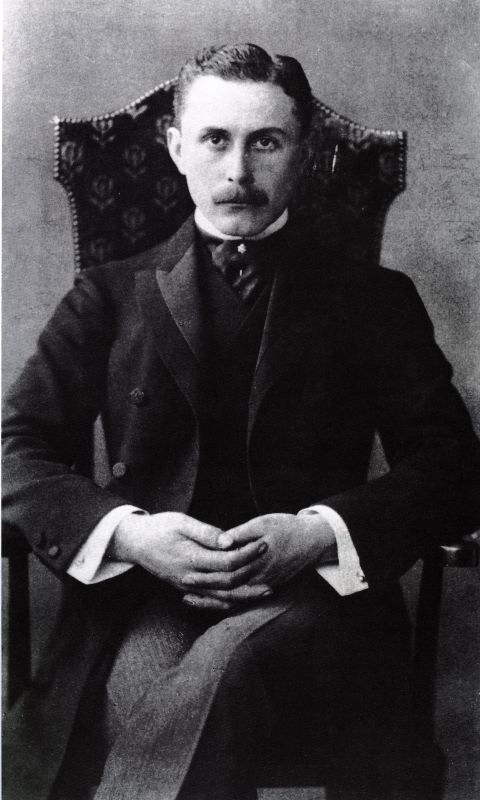- Adolf Loos
Infobox Architect

caption=
name=Adolf Loos
nationality=
birth_date=birth date|1870|12|10
birth_place=Brno ,Austria-Hungary
death_date=death date and age|1933|08|23|1870|10|12
death_place=Vienna ,Austria
practice_name=
significant_buildings= Steiner House, Goldman & Salatsch Building (Looshaus)
significant_projects=
awards=|Adolf Loos (10 December 1870 – 23 August 1933) was one of the most important and influential
Austria n andCzechoslovak [http://www.architektursprache.de/pdf/02.01.02_adolf-loos.pdf]architects of EuropeanModern architecture . In hisessay "Ornament and Crime " he repudiated the florid style of theVienna Secession , the Austrian version ofArt Nouveau . In this and many other essays he contributed to the elaboration of a body of theory and criticism ofModernism in architecture.Life
Born in 1870 in
Brno ,Moravia , Loos was only nine when his stonemason father died. A rebellious boy who rather lost his bearings, he failed in various attempts to get through architecture school. Contracting syphilis in the brothels of Vienna, by 21 he was sterile and in 1893 his mother disowned him. He went to America for three years, and did odd jobs in New York, somehow finding himself in that process and returning to Vienna in 1896 a man of taste and intellectual refinement, immediately entering the fashionable Viennese intelligentsia. His friends includedLudwig Wittgenstein ,Arnold Schönberg , andKarl Kraus . He quickly established himself as the preferred architect of Vienna’s cultured bourgeoisie. Diagnosed with cancer in 1918, his stomach, appendix and part of his intestine were removed. For the rest of his life he could only digest ham and cream. He had several unhappy marriages. By the time he was fifty he was almost completely deaf; in 1928 he was disgraced by a paedophilia scandal and at his death in 1933 at 63 he was penniless.cite book | last = Bock | first = Ralf | title = Adolf Loos | publisher = Skira | location = Geneve | year = 2007 | isbn = 8876246436 ] He died inKalksburg nearVienna .Architectural theory
To fully understand Loos’s radical, innovative outlook on life, his admiration for the classical tradition, his passion for all aspects of design, lifestyle and taste, and the breadth of his ideas it is essential to read his own collected writings, which were published by MIT press in English as “Spoken into the Void” in 19kk.
In his essays, Loos was fond of using the provocative
catch phrase and has become noted for one particularessay /manifesto entitled "Ornament and Crime " written in 1908, in which he repudiated the florid style of theVienna Secession , the Austrian version ofArt Nouveau .In this essay, he explored the idea that the progress of culture is associated with the deletion of ornament from everyday objects, and that it was therefore a crime to force craftsmen or builders to waste their time on ornamentation that served to hasten the time when an object would become obsolete. Perhaps surprisingly, Loos' own architectural work is often elaborately decorated. The visual distinction is not between complicated versus plain, but between "organic" and superfluous decoration.
Loos was also interested in the
decorative art s, collectingsterling silver and high qualityleather goods, which he noted for their plain yet luxurious appeal. He also enjoyed fashion and men's clothing, designing the famed Knize of Vienna, ahaberdasher y.Loos is known for his entry to the 1922 Chicago Tribune competition, which took the form of a single colossal
Doric column . But it was in the field of private houses that he most completely developed his unique spatial language.Major works
* 1908 American Bar, Vienna
* 1910 Steiner House, Vienna
* 1910 Goldman & Salatsch Building, a mixed-use building overlooking Michaelerplatz, Vienna (known colloquially as the "Looshaus")
* 1922 Rufer House, Vienna
* 1925 Maison Tzara, house and studio forTristan Tzara , one of the founders ofDadaism , inMontmartre ,Paris , GIS coordinates: +48.888146, +2.335500
* 1926 Villa Moller, Vienna
* 1927 House (not built) in Paris for the American entertainerJosephine Baker
* 1928Villa Muller ,Prague (now in theCzech Republic )
* 1929 Khuner Villa, Kreuzberg, AustriaNotes
Bibliography
*
*
*
*
*References
*cite book | last = Gravagnuolo | first = Benedetto | title = Adolf Loos, Theory and Works | publisher = Art Data | location = London | year = 1995 | isbn = 0948835168
*cite book | last = Bock | first = Ralf | title = Adolf Loos | publisher = Skira | location = Geneve | year = 2007 | isbn = 8876246436
*cite book | last = Rukschcio | first = Burkhardt | coauthors=Schachel, Roland| title = Adolf Loos-Leben Und Werk | publisher = Residenz | location = Salzburg | year = 1982 | isbn = 3701702888
*cite book | last = Foster | first = Hal | title = Design and Crime (And other diatribes) | publisher = Verso | location = London | year = 2003 | isbn = 9781859844533
*cite book | last = Ottillinger | first = Eva | title = Adolf Loos Wohnkonzepte und Möbelentwürfe. | publisher = Residenz Verlag | location = Salzburg | year = 1994 | isbn = 9783701708505
*
*Oechslin, Werner, "Stilhülse und Kern : Otto Wagner, Adolf Loos und der evolutionäre Weg zur modernen Architektur", Zuerich 1994.External links
*
* [http://www.postrealism.com/adolf.htm Biography and significant buildings of Loos in Vienna]
* [http://www.greatbuildings.com/architects/Adolf_Loos.html Life and important works]
*cite web |url=http://www.bdonline.co.uk/story.asp?sectioncode=429&storycode=3100078&c=2&encCode=00000000013eda51 |title=Adolf Loos seen through the keyhole |accessmonthday=11-19 |accessyear=2007 |last=Muirhead |first=Thomas |coauthors= |format= |work= |publisher=Building Design |pages= |language= |quote= Persondata
NAME= Loos, Adolf
ALTERNATIVE NAMES=
SHORT DESCRIPTION= Austrian Architect
DATE OF BIRTH=1870-12-10
PLACE OF BIRTH=Brno
DATE OF DEATH=1933-08-23
PLACE OF DEATH=Kalksburg
Wikimedia Foundation. 2010.
